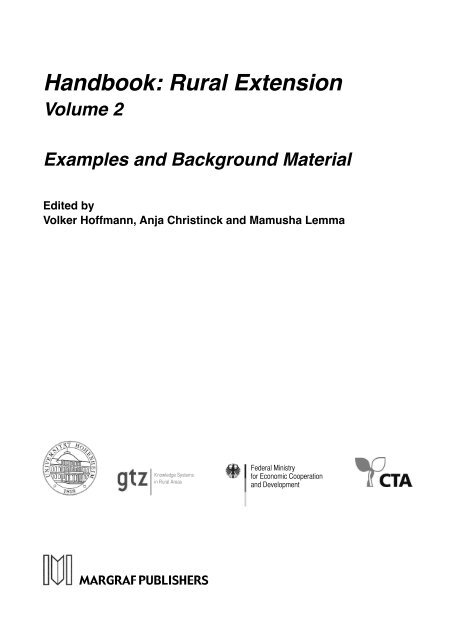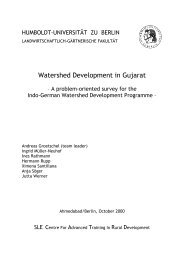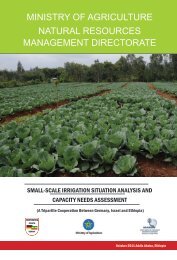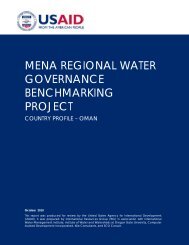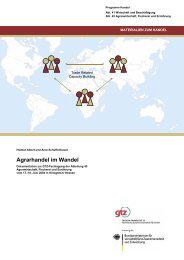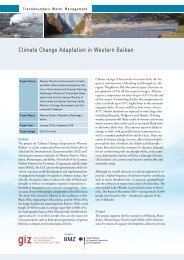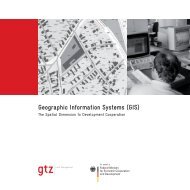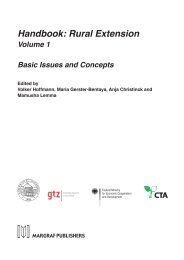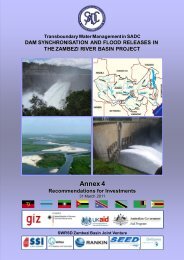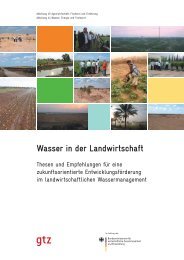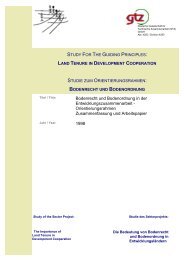Handbook Rural Extension Volume 2.pdf - agriwaterpedia.info
Handbook Rural Extension Volume 2.pdf - agriwaterpedia.info
Handbook Rural Extension Volume 2.pdf - agriwaterpedia.info
You also want an ePaper? Increase the reach of your titles
YUMPU automatically turns print PDFs into web optimized ePapers that Google loves.
<strong>Handbook</strong>: <strong>Rural</strong> <strong>Extension</strong><br />
<strong>Volume</strong> 2<br />
Examples and Background Material<br />
Edited by<br />
Volker Hoffmann, Anja Christinck and Mamusha Lemma<br />
Knowledge Systems<br />
in <strong>Rural</strong> Areas<br />
Federal Ministry<br />
for Economic Cooperation<br />
and Development<br />
MARGRAF PUBLISHERS
Volker Hoffmann, Anja Christinck and Mamusha Lemma (Eds)<br />
<strong>Handbook</strong>: <strong>Rural</strong> <strong>Extension</strong> <strong>Volume</strong> 2<br />
Examples and Background Material<br />
Bibliographic <strong>info</strong>rmation published by „Die Deutsche Bibliothek“<br />
Die Deutsche Bibliothek lists this publication in the Deutsche Nationalbibliografie;<br />
detailed bibliographic data is available in the Internet at http://dnb.ddb.de.<br />
Typesetting and Layout<br />
Volker Hoffmann<br />
Proofreading<br />
Christopher Hay, ecotranslator<br />
Graphics<br />
Volker Hoffmann, Vinzenz Bauer, Stefan Burkart<br />
Printing and Binding<br />
TZ-Verlag & Print GmbH, Roßdorf<br />
© Margraf Publishers GmbH, Scientific books, 2009<br />
Kanalstraße 21; D-97990 Weikersheim<br />
www.margraf-publishers.com; <strong>info</strong>@margraf-publishers.com<br />
ISBN 978-3-8236-1572-9<br />
Margraf Publishers GmbH
About CTA<br />
The Technical Centre for Agricultural and <strong>Rural</strong> Cooperation (CTA) was established in 1983 under the Lomé Convention<br />
between the ACP (African, Caribbean and Pacific) Group of States and the European Union Member<br />
States. Since 2000, it has operated within the framework of the ACP-EU Cotonou Agreement. CTAʼs tasks are to<br />
develop and provide products and services that improve access to <strong>info</strong>rmation for agricultural and rural development,<br />
and to strengthen the capacity of ACP countries to acquire, process, produce and disseminate <strong>info</strong>rmation<br />
in this area.<br />
CTA is financed by the European Union.<br />
CTA<br />
Postbus 380<br />
6700 AJ Wageningen<br />
The Netherlands<br />
www.cta.int
This manual is dedicated to<br />
Hans Rheinwald Erna Hruschka Hartmut Albrecht<br />
the founders of <strong>Extension</strong> Science<br />
at Hohenheim University<br />
The author of this book is near-drowning in a basin,<br />
and what should have been done to reanimate him. As<br />
well as about water disasters in general.<br />
Who wants to teach and advise others<br />
Has at first hand to live self<br />
accordingly.<br />
BECKER, 1786, 331
Table of Contents Vol. 2<br />
Table of Contents Vol. 2 .......................................................................................................... V<br />
Table of Contents Vol. 1 ......................................................................................................... IX<br />
A Case studies of approaches to extension................................................... 1<br />
A 1 Knowledge system based extension: The US Cooperative <strong>Extension</strong> Service............ 2<br />
A 2 Client managed extension: Advisory Circles in Germany............................................ 8<br />
A 3 Production technology approach: "Opération Riz" in Madagascar............................ 18<br />
A 4 Improvement of farming systems: The "Ladder of Progress Approach"<br />
in Salima, Lakeside Region, Malawi ........................................................................... 22<br />
A 5 Socio-economic development approach: "Community Development"<br />
in India .......................................................................................................................... 26<br />
A 6 Socio-economic development approach: "Animation <strong>Rural</strong>e" in francophone<br />
Africa ....................................................................................................................32<br />
A 7 Action research and education: The "Comilla Approach" in Bangladesh ................. 36<br />
A 8 Promoting basic training: "Farmer Training Centers" in Kenya and Senegal ........... 40<br />
A 9 <strong>Extension</strong> by farmers’ associations: The history of agricultural extension in<br />
Taiwan .......................................................................................................................... 44<br />
A 10 The "CFSME” extension system in Rwanda............................................................... 46<br />
A 11 The "Training and Visit System" of the World Bank.................................................. 54<br />
A 12 Research and development: Improving agricultural land-use systems by<br />
"Farming Systems Research" ....................................................................................... 62<br />
A 13 Group based ecological learning and problem solving:<br />
The “Farmer Field School”........................................................................................... 68<br />
A 14 Self-help extension: Farmer-to-farmer extension........................................................ 76<br />
A 15 Experiences with “Socio-Economic Advisory Work” in German agriculture........... 84<br />
A 16 Farmer groups for research and extension: CIALS..................................................... 91<br />
A 17 Learning for Sustainability (LforS): An extension approach in small scale<br />
farming .......................................................................................................................... 97<br />
B Selected project descriptions........................................................................ 113<br />
B 1 Assessing service quality at the Latvian <strong>Rural</strong> Advisory and Training Center........ 114<br />
B 2 <strong>Extension</strong> services aimed at improving the food situation in the project: Paktia<br />
Province in Afghanistan.............................................................................................. 122<br />
B 3 The T&V oriented reorganization of agricultural extension in the Atlantic<br />
Province of the People's Republic of Benin............................................................... 124<br />
V
B 4<br />
B 5<br />
B 6<br />
Competitive funding of agricultural research with farmer participation:<br />
Concepts and achievements of the AGRAN project in Benin (1999-2006) ............139<br />
Self-help groups and associations among the Tiv in Nigeria....................................145<br />
Reorganization of extension: Introducing fee-based agricultural extension in<br />
Azerbaijan ...................................................................................................................147<br />
B 7 Reorganization of extension: The ECWA Church in Northern Nigeria...................160<br />
B 8 Can entrepreneurship training for German farmers be effective for rural<br />
producers in Burkina Faso? .......................................................................................165<br />
B 9 Reorganization of extension: The history of extension in Malawi ...........................172<br />
C<br />
Description of recurring problems..............................................................177<br />
C 1 "<strong>Extension</strong>", an international terminology problem ..................................................178<br />
C 2 "The Cow": an example of failure in intercultural communication..........................181<br />
C 3 Traditional knowledge in client groups and communicating new<br />
agricultural <strong>info</strong>rmation...............................................................................................188<br />
C 4 Effectiveness and design of pictorial representation..................................................192<br />
C 5 Strategic communication between projects and their client groups:<br />
a cautionary example in Nigeria .................................................................................204<br />
C 6 Experience with technical demonstrations in agricultural extension programs. ......219<br />
C 7 Problems of working with contact farmers ................................................................222<br />
C 8 Problems of service delivery by public service organizations/government<br />
administrations.............................................................................................................224<br />
C 9 Problems of leadership style in organizations............................................................226<br />
C 10 Problems with the development and introduction of participatory methods:<br />
From RRA via PRA to PLA .......................................................................................231<br />
C 11 Working with women in agricultural extension.........................................................235<br />
D Cases and examples of method ...................................................................239<br />
D 1 The problem-solving method of RIP in Botswana ....................................................240<br />
D 2 Problem-solving approach in the Tetu <strong>Extension</strong> Project in Kenya .........................241<br />
D 3 Deciding on extension methods in the Kawinga RDP in Malawi.............................243<br />
D 4 Committees as intermediaries between client groups and development<br />
organizations in Malawi..............................................................................................247<br />
D 5 The role of stimulation in the CFSME extension system in Kibuye, Rwanda.........250<br />
D 6 Awareness creation and training in the CFSME extension system<br />
in Kibuye, Rwanda ......................................................................................................259<br />
D 7 "Majeutics" - GRAAP's pedagogic approach to self-development ..........................274<br />
VI
D 8<br />
D 9<br />
A table of contents of an extension program: The "Goat Project" in Ngozi,<br />
Burundi ........................................................................................................................ 283<br />
"<strong>Extension</strong> Centre Day": festivities and agricultural exhibition by CARDER<br />
Atlantique, Benin......................................................................................................... 286<br />
D 10 Strategic <strong>Extension</strong> Campaigns.................................................................................. 293<br />
D 11 Financing agricultural extension in an input supply cooperative in Romania ......... 298<br />
D 12 Transforming research results into extension methods and extension aids.<br />
Designing extension material for the promotion of agricultural innovation<br />
among farmers with low levels of literacy in Benin .............................................300<br />
D 13 Participatory <strong>Rural</strong> Appraisal: Method and Tools..................................................... 320<br />
D 14 The “Road to Progress”: A simulation game for needs assessment compatible<br />
with PRA ..................................................................................................................... 338<br />
D 15 The SWOT analysis .................................................................................................... 343<br />
D 16 Strengthening endogenous knowledge production through intercultural<br />
dialogue ....................................................................................................................... 346<br />
D 17 Promoting local innovation - a tool for sustainable rural development ................ 354<br />
D 18 Video production for women-to-women extension in Bangladesh ......................366<br />
D 19 Coping with the “Farm Crisis”: The Iowa Farm Financial Planning Program.....368<br />
D 20 Learning for Sustainability – LforS. Simulation games – a creative tool for<br />
interactive learning................................................................................................371<br />
D 21 Learning for Sustainability – LforS: Stakeholder dialogue ..................................375<br />
E Practical Guidelines ........................................................................................... 381<br />
E 1 Identifying client groups and differentiating sub-groups .......................................... 382<br />
E 2 Participation of client groups...................................................................................... 385<br />
E 3 Deciding on client groups and development measures ............................................. 387<br />
E 4 How to select contact farmers..................................................................................... 389<br />
E 5 The methodology of extension talks .......................................................................... 394<br />
E 6 Laying out and using plots to demonstrate crop rotations......................................... 402<br />
E 7 Principles and guidelines for extension projects........................................................ 406<br />
E 8 Programming field days.............................................................................................. 410<br />
E 9 <strong>Extension</strong> work at markets.......................................................................................... 413<br />
E 10 Using local agricultural exhibitions for extension work ........................................... 415<br />
E 11 Establishing a school garden....................................................................................... 417<br />
E 12 Evaluating facilitated training events ......................................................................... 419<br />
E 13 Pre-testing pictorial material....................................................................................... 425<br />
VII
E 14 Structuring group sessions to identify problems........................................................428<br />
E 15 Using visualization to improve group communication..............................................430<br />
E 16 Sharing knowledge via the worldwide web: Options for e-collaboration in rural<br />
extension ......................................................................................................................438<br />
F<br />
Checklists................................................................................................................443<br />
F 1 Checklist of constraints on participation of client groups .........................................444<br />
F 2 Checklist of weaknesses in extension work ...............................................................446<br />
F 3 Checklist for using media............................................................................................448<br />
F 4 Checklist for <strong>info</strong>rmation gathering in the situation analysis....................................453<br />
F 5 Criteria to predict the financing of extension through the clients in farmers’<br />
associations ..................................................................................................................457<br />
F 6 Professional ethics and elements of a possible code of conduct for rural<br />
advisers ........................................................................................................................459<br />
F 7 Checklist for selecting contact farmers.......................................................................465<br />
F 8 Points for the field adviser to bear in mind when forming village committees........468<br />
F 9 Points to bear in mind when preparing and conducting individual extension<br />
talks .............................................................................................................................471<br />
F 10 The advisory process: Questions for guidance...........................................................473<br />
F 11 Checklist for preparing and running a meeting during a campaign..........................475<br />
G Presentation and structure: examples and suggestions .................479<br />
G 1<br />
G 2<br />
G 3<br />
G 4<br />
H<br />
H 1<br />
H 2<br />
H 3<br />
Learning for Sustainability – LforS: Training modules and workshop<br />
guidelines.....................................................................................................................480<br />
Instructional material for awareness raising and training from the agricultural<br />
extension project Nyabisindu, Rwanda ....................................................................484<br />
Instructional material for awareness raising and training from GRAAP,<br />
Burkina Faso................................................................................................................498<br />
Examples of cost/benefit development in financing extension work in an<br />
input supply cooperative in Romania .........................................................................509<br />
Some great personalities and their achievements for extension.513<br />
Rudolf Zacharias Becker, the promoter of enlightenment in Germany....................514<br />
Grundtvig’s ideas of popular education: „Folkehøjskoler“, the Danish adult<br />
education centers ........................................................................................................523<br />
Alexander Tschajanow and Social Agronomy...........................................................528<br />
H 4 Kurt Lewin: Field theory – action research – group dynamics -<br />
Some basic concepts for extension.............................................................................536<br />
VIII
H 5 Carl Rogers: Client centered counseling and learning in freedom ........................... 541<br />
H 6 Paulo Freire’s pedagogical approach: The acting human being ............................. 548<br />
Table of Contents Vol. 1<br />
Preface by the Editors................................................................................................................VI<br />
Aknowledgements ...................................................................................................................... X<br />
Table of Contents Vol. 1............................................................................................................XI<br />
Table of Contents Vol. 2.......................................................................................................... XV<br />
List of Boxes, Figures, Tables................................................................................................XIX<br />
Abbreviations and Acronyms.................................................................................................XXI<br />
1 Importance and role of extension in rural development............................. 1<br />
1.1 <strong>Rural</strong> poverty and its main causes ............................................................................ 3<br />
1.2. Assistance for farmers: Background and basic approaches.................................. 5<br />
1.2.1 Typical features of the situation of small farmers ........................................................ 6<br />
1.2.2 Basic approaches to assistance for small farmers ........................................................ 9<br />
1.2.3 Basic approaches to assistance for emerging and commercial farmers .................... 10<br />
1.3 Experiences with extension....................................................................................... 11<br />
1.3.1 Nomen est omen – extension terminology ................................................................. 11<br />
1.3.2 Selected cases of extension history ............................................................................. 14<br />
1.3.3 Problems of public delivery of extension ................................................................... 16<br />
1.3.4 Recent changes and trends in extension...................................................................... 20<br />
1.4 Our understanding and vision for extension ......................................................... 25<br />
1.4.1 Definitions of advisory and extension work............................................................... 25<br />
1.4.2 General requirements for extension workers and advisers ........................................ 28<br />
1.4.3 Benefits for community and society ........................................................................... 29<br />
2 Approaches to extension......................................................................................... 31<br />
2.1 Classification of approaches..................................................................................... 31<br />
2.1.1 The production technology approach.......................................................................... 35<br />
2.1.2 The problem-solving approach and its consequences................................................ 38<br />
2.2 Developing and implementing a problem-solving approach............................... 39<br />
2.2.1 Client group orientation............................................................................................... 40<br />
2.2.2 Client group participation............................................................................................ 43<br />
2.2.3 Phased project planning and implementation............................................................. 44<br />
IX
3 Basic concepts for extension ....................................................................48<br />
3.1 Explanation of the selection and use of concepts...................................................48<br />
3.2 Framework model of extension................................................................................51<br />
3.3 Four reference examples from extension practice.................................................53<br />
3.4 Behaviour and behaviour modification ..................................................................55<br />
3.5 Perception and defence mechanisms.......................................................................58<br />
3.6 Problem solving and decision making.....................................................................61<br />
3.7 Groups and group processes.....................................................................................71<br />
3.8 Social structure and the institutions of society.......................................................74<br />
3.9 Culture.........................................................................................................................75<br />
3.10 Communication ..........................................................................................................77<br />
3.10.1 Direct personal communication...................................................................................77<br />
3.10.2 Public community communication..............................................................................79<br />
3.10.3 Communication via technical media...........................................................................80<br />
3.10.4 Communication networks............................................................................................81<br />
3.11 Structuring of learning processes ............................................................................83<br />
3.12 Organization and management................................................................................85<br />
3.13 Knowledge management ...........................................................................................89<br />
3.14 Innovation and change management ......................................................................94<br />
3.14.1 The diffusion of innovations........................................................................................94<br />
3.14.2 Change management in communities and organizations.........................................105<br />
4 <strong>Extension</strong> content ................................................................................................108<br />
4.1. The research extension continuum........................................................................109<br />
4.2 The yield gap.............................................................................................................110<br />
4.3 Research extension links .........................................................................................113<br />
4.4 Information needs analysis .....................................................................................115<br />
4.5 Facilitating farmer experimentation and participatory technology<br />
development ..............................................................................................................117<br />
4.6 Scaling up and out, or simply diffusion? ..............................................................119<br />
5 <strong>Extension</strong> methods..............................................................................................121<br />
5.1 Individual extension.................................................................................................122<br />
5.1.1 The extension talk ......................................................................................................123<br />
5.1.2 Individual extension on the farm...............................................................................125<br />
5.1.3 Individual extension in the office or home of the field adviser ...............................125<br />
X
5.1.4 Individual extension by telephone and through letters or e-mail............................. 126<br />
5.1.5 Individual extension in the market place and religious places ................................ 126<br />
5.2 Group extension ....................................................................................................... 127<br />
5.2.1 Formation of groups................................................................................................... 128<br />
5.2.2 Settings for working with groups.............................................................................. 128<br />
5.2.2.1 Group discussion........................................................................................................129<br />
5.2.2.2 “<strong>Extension</strong> group” – extension circle........................................................................ 131<br />
5.2.2.3 Demonstrations ..........................................................................................................132<br />
5.2.2.4 Field trips, farm visits, excursions............................................................................. 135<br />
5.2.2.5 <strong>Extension</strong> work in training centres............................................................................ 137<br />
5.2.2.6 <strong>Extension</strong> in rural schools.......................................................................................... 138<br />
5.3 <strong>Extension</strong> for a larger public.................................................................................. 140<br />
5.3.1 Information meeting .................................................................................................. 141<br />
5.3.2 Field day ..................................................................................................................... 142<br />
5.3.3 Agricultural competitions/contests............................................................................ 144<br />
5.3.4 Agricultural shows, exhibitions ................................................................................ 145<br />
5.3.5 Campaigns.................................................................................................................. 147<br />
6 Use of extension aids and media .................................................................. 151<br />
6.1 The potential of media............................................................................................. 151<br />
6.2 Types of extension aids............................................................................................ 152<br />
6.2.1 The spoken and written word .................................................................................... 155<br />
6.2.2 Pictorial illustration....................................................................................................157<br />
6.2.3 Slides and films..........................................................................................................159<br />
6.2.4 Video recordings........................................................................................................ 161<br />
6.2.5 Radio and television................................................................................................... 161<br />
6.2.6 Three dimensional presentation ................................................................................ 162<br />
6.2.7 Methods of live presentation ..................................................................................... 163<br />
6.3 ICT – an integrative media tool ............................................................................. 163<br />
7 Organizing and managing extension ........................................................... 165<br />
7.1 Organizational issues in extension......................................................................... 165<br />
7.1.1 Forms and types of extension organizations............................................................. 165<br />
7.1.2 Differentiating between public and private interest ................................................. 166<br />
7.1.3 Financing extension services..................................................................................... 167<br />
XI
7.1.4 Leadership style and organization structure for extension services.........................169<br />
7.2 Managing extension work.......................................................................................170<br />
7.2.1 Situation analysis........................................................................................................170<br />
7.2.1.1 Methods for collecting <strong>info</strong>rmation – an overview ..................................................180<br />
7.2.1.2 Situation analysis as a basis for planning extension.................................................180<br />
7.2.1.3 Importance of the analysis of the social system when working abroad...................180<br />
7.2.2 Planning and programming of extension ..................................................................181<br />
7.2.3 Connecting extension with complementary services ...............................................182<br />
7.2.3.1 Research .....................................................................................................................183<br />
7.2.3.2 Infrastructure ..............................................................................................................183<br />
7.2.3.3 Provision of production means..................................................................................184<br />
7.2.3.4 Credit...........................................................................................................................184<br />
7.2.3.5 Marketing....................................................................................................................186<br />
7.2.3.6 Information services...................................................................................................186<br />
7.2.4 Monitoring and evaluation of extension ...................................................................187<br />
7.2.4.1 What is M&E?............................................................................................................187<br />
7.2.4.2 Designing an M&E System .......................................................................................188<br />
7.2.4.3 Special issues and challenges for M&E of extension support .................................193<br />
7.2.4.4 Impact assessment, the attribution gap and cost considerations ..............................197<br />
7.3 Organization and management in a decentralized and pluralistic<br />
extension world.........................................................................................................199<br />
7.3.1 The old order dissolves ..............................................................................................199<br />
7.3.2 The need for a professional organization..................................................................200<br />
8 Capacity Building for <strong>Extension</strong>.....................................................................202<br />
8.1 Professional and personal requirements of an adviser.......................................203<br />
8.2 Training approach and requirements for training advisers..............................205<br />
8.3 Type of trainees, learning opportunities and ways of learning .........................206<br />
8.4 Training strategies ...................................................................................................207<br />
8.4.1 Basic training for field advisers.................................................................................208<br />
8.4.2 From a “beginner” to a junior staff member: Training and further<br />
qualification of job starters ........................................................................................209<br />
8.4.2.1 Induction period .........................................................................................................209<br />
8.4.2.2 Specific training courses ............................................................................................210<br />
8.4.2.3 On-the-job training.....................................................................................................210<br />
XII
8.4.2.4 Backstopping and accompaniment............................................................................ 210<br />
8.4.3 Becoming a better senior adviser .............................................................................. 211<br />
8.4.3.1 Special supplementary courses.................................................................................. 211<br />
8.4.3.2 Continuous further training ....................................................................................... 212<br />
8.4.4 Becoming a good extension manager ....................................................................... 214<br />
8.4.5 Selection and use of teaching staff for the training of advisers ............................... 215<br />
8.4.5.1 Academic training......................................................................................................215<br />
8.4.5.2 Qualified teaching and training staff......................................................................... 215<br />
8.5 Use of teaching aids.................................................................................................. 216<br />
9 The future of rural extension............................................................................ 217<br />
9.1 Industrialized countries .......................................................................................... 217<br />
9.2 Countries in transition ............................................................................................ 219<br />
9.3 Least developed countries....................................................................................... 221<br />
10 Bibliography................................................................................................................ 223<br />
XIII
A<br />
Case studies of approaches to extension<br />
A 1 Knowledge system based extension: The US Cooperative <strong>Extension</strong> Service............ 2<br />
A 2 Client managed extension: Advisory Circles in Germany ........................................... 8<br />
A 3 Production technology approach: "Opération Riz" in Madagascar............................ 18<br />
A 4 Improvement of farming systems: The "Ladder of Progress Approach"<br />
in Salima, Lakeside Region, Malawi ........................................................................... 22<br />
A 5 Socio-economic development approach: "Community Development"<br />
in India .......................................................................................................................... 26<br />
A 6 Socio-economic development approach: "Animation <strong>Rural</strong>e" in francophone<br />
Africa ....................................................................................................................32<br />
A 7 Action research and education: The "Comilla Approach" in Bangladesh. ............... 36<br />
A 8 Promoting basic training: "Farmer Training Centers" in Kenya and Senegal. ......... 40<br />
A 9 <strong>Extension</strong> by farmers’ associations: The history of agricultural extension in<br />
Taiwan .......................................................................................................................... 44<br />
A 10 The "CFSME” extension system in Rwanda. ............................................................. 46<br />
A 11 The "Training and Visit System" of the World Bank. ................................................ 54<br />
A 12 Research and development: Improving agricultural land-use systems by<br />
"Farming Systems Research" ....................................................................................... 62<br />
A 13 Group based ecological learning and problem solving:<br />
The “Farmer Field School” .......................................................................................... 68<br />
A 14 Self-help extension: Farmer-to-farmer extension........................................................ 76<br />
A 15 Experiences with “Socio-Economic Advisory Work” in German agriculture........... 84<br />
A 16 Farmer groups for research and extension: CIALS..................................................... 91<br />
A 17 Learning for Sustainability (LforS): An extension approach in small scale<br />
farming .......................................................................................................................... 97<br />
1


